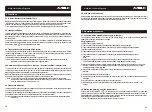
Make Your Job More Enjoyable
J\
�
VAC
3.3 Sensitivity level settings
Sensitivity level can be set as required b,lthe end user. If it is necessary to change the sensitivity level,
please press "Sensitivity Adjust Button" ( 'v ). Three sensitivity levels can be circularly adjusted.
3.4 Setting of Environment Zero function
Automatic environment zeroing function is started by default.
Long press button "Environment Zero" (
Q)
(for more than 3seconds) and the beeper gives one "BEEP"
sound and the auto "Environment Zero" function is cancelled and system enters manual "Environment
Zero" state. Under the state, short press the button "Environment Zero" ( Q ) and the beeper gives one
"BEEP" sound and manually zero one time the current environment concentration. Long press the button
"Environment Zero" (
Q)
(for more than 3seconds) and the beeper gives one "BEEP" sound, the system
is transferred to auto "Environment Zero" function.
3.5 Leakage detection and positioning
Move slowly the probe through the location area where leaks may occur (for a flexible probe, just bend it to
a desired shape to extend it to the required area). If a leakage is detected, the leak detector alarms. With
refrigerant concentration increases, the alarming frequency of leak detector speeds up and the number of
LED leakage indicator lamps increase. While the device alarms, it means that you are close to the leaking
source. Re-check the neighbored area and make sure if it alarms again. If the leaking source is
determined, move slowly from different directions of the non-alarming area towards the leaking source to
position accurately the leaking source. Additionally, with the help of "Environment Zero" function and
sensitivity adjustment, accurately position the leaking point (first use high sensitivity to find the leaking
area, then reduce the sensitivity level and repeat the above procedures to determine the leaking source.).
Once the leaking source is determined, make corresponding marks near the leaking source and then
check the entire refrigerating system till all the leaking points are found.
&
Note:
Q)At detecting, there shall be some pressure (2:50 psi) in the system and the operation shall be performed
in relatively static air condition. If there is wind, leaked refrigerant gas can be quickly diluted or be blown
away from the leaking source, thus affect the accuracy of detection. Additionally, before detection, use a
fan to blow off the suspected leaked refrigerant gas in the system in case it may affect the accuracy of
detection.
@"Auto Environment Zero" function is started by default. If the leak detector alarms before positioning the
leaking source, the device will automatically shield the environmental refrigerant concentration. If the
"Auto Environment Zero" function is off, the "Environment Zero button" 0 ) has to be used to shield the
environmental refrigerant concentration.
@ Leaking source usually occurs at the greasy dirt, dust position, node valve or pipe connection positions.
Detection shall focus on these areas.
© While detecting, the probe of the leak detector shall be 1/8"-1/4" away from the suspected leaking point
to prevent greasy oil and others from contaminating the probe and affecting the detection accuracy. The
probe shall move at a speed of around 1 inch/second.
04
Make Your Job More Enjoyable
J\
�
VAC
4. Maintenance
4.1 Proper maintenance can prolong the service time and maintain the performance of the leak detector.
Keep the protective cover of the sensor clean and make sure there is no water drop, oil, grease, dust or
other contaminants on the surface of the sensor. Clean the sensor with cotton cloth or dry gas.
4.2
The sensor has its working time. Under normal condition, its service time is more than a year. Long
time working in high-concentration refrigerant environment will rapidly consume the life time of the
sensor. When the sensor is out of service, replace it in time.
4.3
First remove the sensor protective cover; then take out the old sensor; align the pins and insert the new
sensor along the same position where the old one was taken out. Reinstall the sensor protective cover.
Refer to the following illustrations.
Compositions of leak detector head: installation seat,
sensor, sensor protective cover
Direction of sensor bump
Sensor installation seat
The protective cover
is removed
5. Accessory list
Leak detector
Micro-USB Power cable
Standard leakage cylinder
Operation manual
Outer case
1pcs
1pcs
1pcs
1pcs
1pcs
05






















